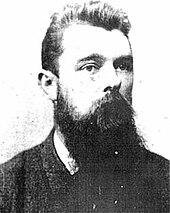Mikael Pedersen
Mikael Pedersen (born October 25, 1855 in Fløng , Denmark , † October 22, 1929 in Bispebjerg , Denmark) was a Danish inventor . He is best known for inventing the Pedersen bicycle .
Life
After finishing school, Pedersen trained as a blacksmith in the Maglekilde Maskinfabric .
Inventions
Pedersen invented and patented, among other things, a new type of threshing machine that could separate grain from chaff, a gear system and a gear for horse-powered mills and a braking system for wagons. He was also musically gifted, and despite being a blacksmith, he was listed as a musician in the 1890 census.
Pedersen was involved in the development of a butter centrifuge for separating cream and butter from milk, which did not have to be stopped to remove the cream. The device was patented in 1878, but to his annoyance, his involvement was not mentioned. Pedersen refined the centrifuge, which earned him patents and considerable income. His enhanced version of the centrifuge is still in use today. Koefoed and Hauberg from Copenhagen bought the rights to the machine and contact RA Lister and Company in Dursley , Gloucestershire to export the machine to England.
In England
Robert Ashton Lister suggested that Pedersen should come to England to assemble the components supplied from Denmark. Pedersen agreed and moved to England with his lover Dagmar in 1889 (he was already separated from his wife Laura at this point). The centrifuge was extremely successful in the English market and made Pedersen so wealthy that he could rent the largest house in Dursley. He frequented the city's society, where he founded a choir, participated in concerts and founded a number of social and sporting associations.
During a visit to Denmark, Pedersen met Ingeborg Jensen, 29 years his junior, and fell in love with her. She moved to Dursley in 1907 and gave birth to the couple's first child, a boy named Palnatoke, in 1908. The connection also had a daughter, who died at the age of two, and two other sons, Vagn (Vaughan) and Svend (* 1914).
In 1900 Pedersen founded a factory in the Pin Mill in Dursley to manufacture the Pedersen bicycle he had developed . However, Pedersen lacked business acumen, lived lavishly and was prone to fraud. He was over 60 when he left Dursley without notice, leaving his family there. Ingeborg then returned to Denmark and married Jens Kristoffer Jensen, who adopted their children. A friend met Pedersen by chance in 1920 in London , where he was selling matches. This friend financed his return to Denmark, where Pedersen died penniless and unknown in 1929. He was buried in an unmarked grave in the Bispebjerg cemetery, a suburb of Copenhagen .
Reburial
In 1995, lovers of the Pedersen bicycle collected donations to exhume the remains of Pedersen and bury them again in Dursley. The service held for the occasion in the same year was attended by over 300 people, including the Bishop of Gloucester, representatives of the Danish embassy and Pedersen's grandchildren.
literature
- David Evans: The Ingenious Mr. Pedersen. 1978.
- Revised version: Mr Pedersen, A Man of Genius . Tempus, 2006, ISBN 0-75244-505-7 .
Web links
- Days gone by: The history of Dursley's Pedersen Bicycle. In: Gloucestershire Gazette, June 27, 2016
- Christopher Follett: The pedaling pioneer who knew how to please petticoat-clad posteriors. In: cphpost.dk of November 15, 2016
- Pedersen Bicycles with a short biography of Pedersen. In: pedersenbicycles.com
- Finn Wodschow: Mikael Pedersen Biography . In: dursley-pedersen.net
| personal data | |
|---|---|
| SURNAME | Pedersen, Mikael |
| BRIEF DESCRIPTION | Danish inventor |
| DATE OF BIRTH | October 25, 1855 |
| PLACE OF BIRTH | Fløng , Denmark |
| DATE OF DEATH | October 22, 1929 |
| Place of death | Bispebjerg , Denmark |


